
Photo from wikipedia
Understanding the structure and behavior of emissions in building systems is the first step toward improving the reliability of the environmental impact assessment of buildings. The shortcomings of current building… Click to show full abstract
Understanding the structure and behavior of emissions in building systems is the first step toward improving the reliability of the environmental impact assessment of buildings. The shortcomings of current building lifecycle assessment (LCA) research is the lack of understanding of embodied emissions and static analysis. This study presents a methodology for the dynamic LCA of buildings, combined with the system dynamics technique. Dynamic factors related to recurrent embodied emissions are explored through a literature review. Applying the dynamic factors based on the review, a causal map and stock-flow diagram are invented. Collecting the field data and establishing the assumptions based on the literature, a case study is performed for the proposed model. As a result, through dynamic analysis, it was found that recurrent embodied emissions have a considerably different behavior from static ones during their whole life. Additionally, it was found that the environmental impacts changed by more than 10%, according to the variation of the users’ required performance level in sensitivity analysis. This result thoroughly addressed the necessity and appropriateness of dynamic LCA. The dynamic LCA model developed in this study can contribute to the long-term behavioral understanding of the embodied environmental impacts of building LCA.
Journal Title: Sustainability
Year Published: 2019
Link to full text (if available)
Share on Social Media: Sign Up to like & get
recommendations!